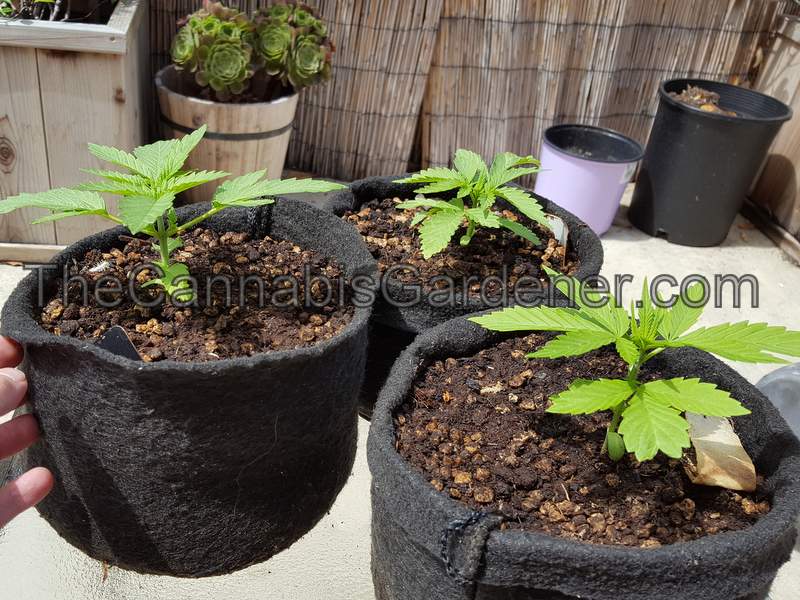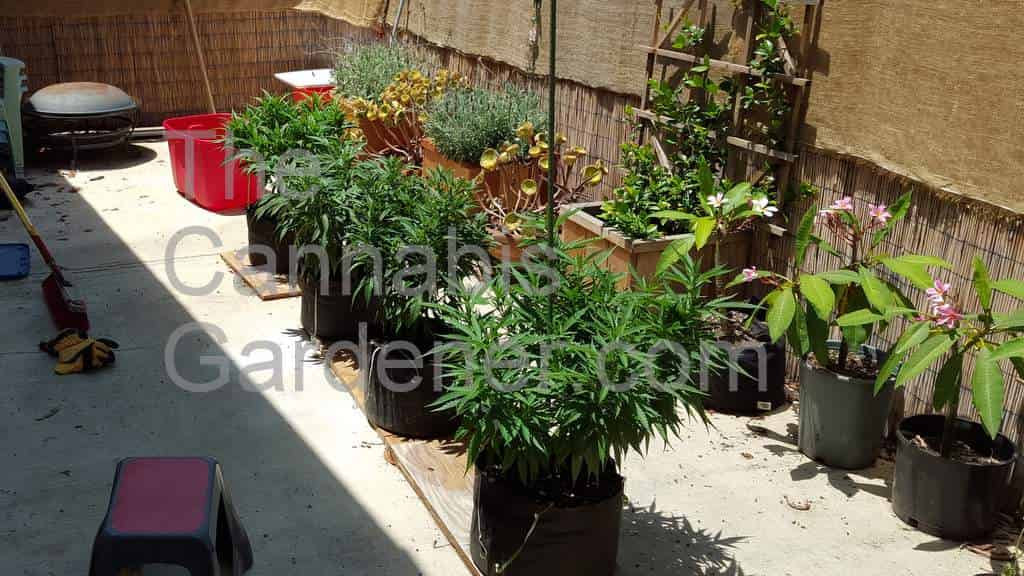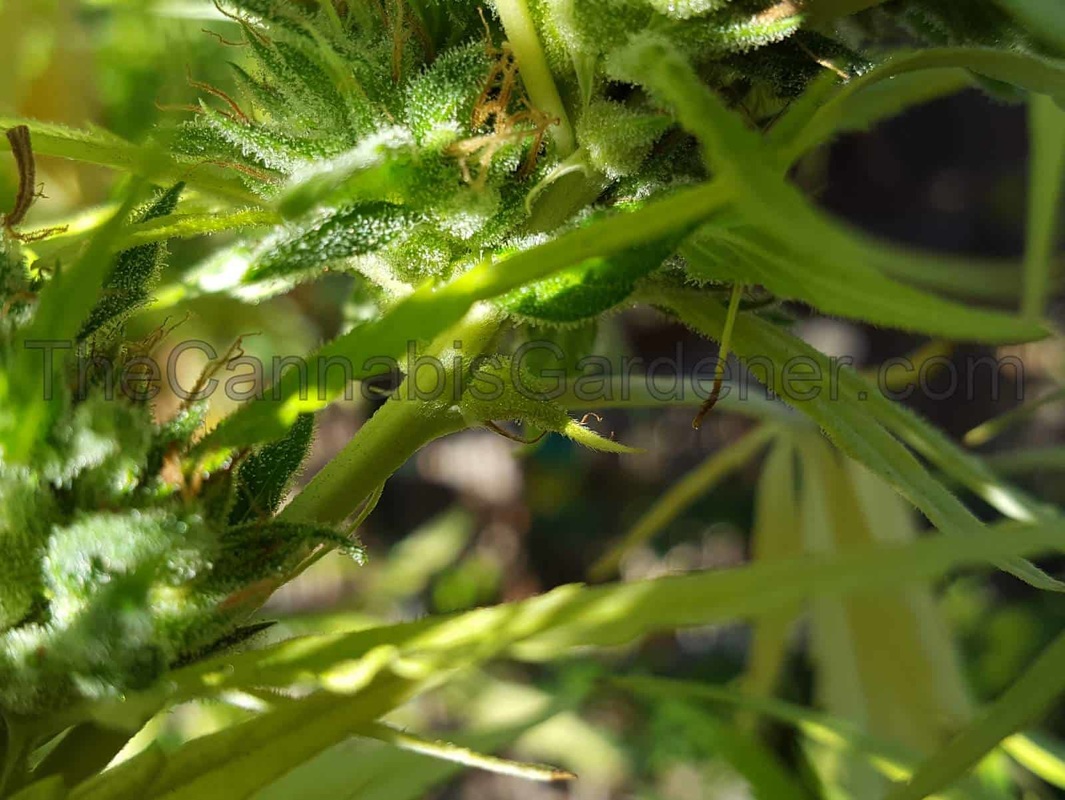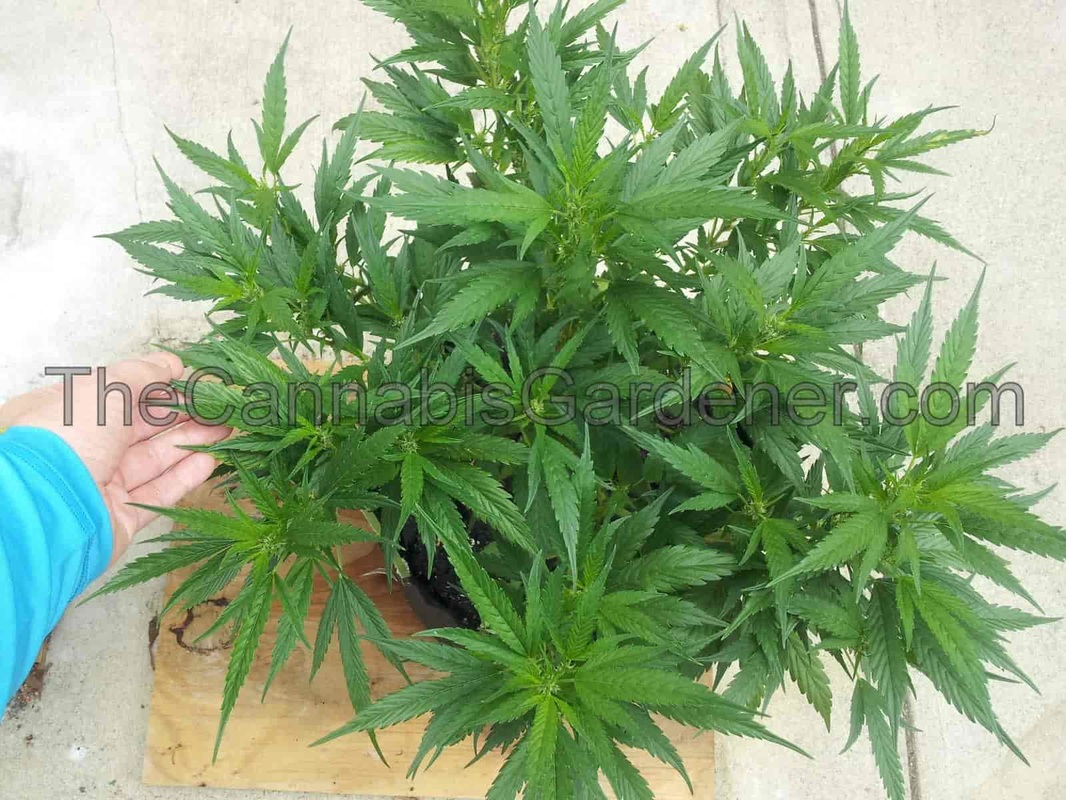Cannabis Vegetative Growth
You've germinated your cannabis seeds in your own homemade organic soil and your young cannabis seedlings are becoming full-fledged marijuana plants. Welcome to the vegetative growth phase of cannabis, the simplest time for the grower. Your plant is going to grow like the weed that it is, especially outdoors in the California sunshine. You'll notice daily growth in your plant; New leaves, new branches, increased height and a thickening trunk. You'll be on autopilot for most of this but as always, you'll need to pay attention and nip things in the bud quickly to prevent larger issues from limiting your plant's potential.
|
Important things to remember during Cannabis Veg
The most important items to remember for vegging cannabis and which are covered in-depth below are:
- Watering your marijuana plant correctly
- Keeping your soil and root system from getting too hot
- Spraying your cannabis regularly to prevent pest infestation
- Transplanting your cannabis into a larger pot
- Checking the sex of your marijuana plant
- Lightly pruning your cannabis to keep powdery mildew off your plants
- Gentle fertilizing with earthworm castings
How to water a Cannabis plant
Watering correctly is the single most important thing to remember as a new marijuana grower. Marijuana plants don't like to be over-watered, and issues like root rot and fusarium wilt can develop if your soil is kept waterlogged. Over-watering will also cause your cannabis plant to appear wilted which to an untrained eye will look like the plant is thirsty and lead to further over-watering.
It is very easy to water your cannabis the right way by following just a few guidelines:
It is very easy to water your cannabis the right way by following just a few guidelines:
- Use dechlorinated water.
- This is especially important since we are growing in living organic soil. Chlorine in the drinking water will kill our organic soil. To ensure your water is dechlorinated, just fill up a container and let the water sit unsealed for 24 hours. Done.
- Water based on soil moisture. Don't water based on a day-of-the-week schedule.
- You can easily check soil moisture by sticking your finger into the top soil down to your first knuckle. If the soil is moist then you shouldn't water. You can also pick up the pot and feel its weight...if the pot it light, the soil is dry and needs to be watered.
- All cannabis plants aren't created equal. They might not be thirsty at the same time.
- Your cannabis plants are all individuals with different needs. You might not need to water them all at the same time unless your soil check determines they need watering.
- When your plant needs to be watered, give it a sip of water 2-3 times over about 15 minutes instead of one big gulp.
- When your plants want to drink, water them all the way. Don't half-water or quarter-water.
- When you water incompletely, the soil that doesn't get water starts to harden and become less water absorbent at the next watering. You also trick yourself into thinking your soil is moist when it isn't...you'll feel moisture in the top soil while the entire bottom half is dried out.
Keeping your root system and soil from becoming too hot
Cannabis roots don't like extremely hot temperatures. Soil and roots that are too warm can not only stress your cannabis plants but warm, moist soil is the perfect condition for fusarium wilt to establish a foothold. Since we're growing marijuana plants outdoors we can't control soil temps completely but we can take a couple simple steps to alleviate extreme heat in the root system. Keep your soil temps cool in the summer heat by:
- If your pots are on concrete or another heat-absorbing surface, insulate them from the surface with a piece of wood.
- If you're using black pots, wrap the pots in something white or light-colored. An old white undershirt is usually a perfect fit.
Spraying your Cannabis plants for bugs
Since we're growing outdoor cannabis, our plants are open to the environment and susceptible to all kinds of different pests. Even seedlings should be inspected for bugs and have them manually removed, but once your plant can stand on its own you should begin regularly inspecting and spraying your plants. As this instruction is a little lengthy I've moved it to a new page which you need to read, Controlling Pests on Cannabis. Since our cannabis is still in the veg state you don't need to read about how to get rid of budworms and spider mites...those won't affect you until your cannabis is flowering which is still a month or two away. For now, just concern yourself with getting rid of aphids, leafhoppers and thrips.
How to transplant a Cannabis plant
After a month or so of vegetative growth, your little cannabis plant will have grown nicely into her 1-gallon smartpot and be ready to slip into something a little more comfortable. I like to go straight from a 1-gallon pot to a 5-gallon pot where my plant will stay until harvesting. Some people prefer smaller steps to avoid having to water an entire 5-gallon pot for a plant that is still quite small. I personally like to avoid stressing my plant with repeated transplants but the choice is entirely up to you and I suggest doing whatever you're comfortable with. When you're ready to transplant, follow my tips for transplanting cannabis below:
Once you're satisfied that all is well, get her back into some nice mild sunlight so she knows everything is fine. If she wilts a little over the next couple days that's okay, she's just stressed by the move. Take your soil-covered hand and pat yourself on the back, you did good!
- Transplant when the soil is drier.
- It will be easier to keep the roots and rootball intact and undamaged if you haven't watered recently.
- Don't expose cannabis roots to direct sunlight.
- Sunlight will kill your roots pretty quickly, so do the transplant quickly to prevent sunlight damage to your root system.
- Have your new pot ready.
- Fill your new pot with soil, then dig a hole in the center for where the transplanted plant will fit. Nothing will be perfect, just do your best. After you've transplanted and watered, the soil will settle a bit so keep extra soil handy...you'll need it.
- A 5-gallon pot full of wet soil is much heavier than a 1-gallon pot. You might need help moving the new pot.
- Don't turn your plant upside down unless you want a soily mess. Instead, tap the sides of your pot to loosen the soil.
- I learned this the hard way years ago. There's no need to turn your cannabis plant upside down to remove it from the pot. Instead, gently tap the sides of the smartpot to break the soil and roots away from the fabric.
- Have dechlorinated water available.
- After the transplant you'll need to welcome your little plant to her new home in freshly-watered soil.
Once you're satisfied that all is well, get her back into some nice mild sunlight so she knows everything is fine. If she wilts a little over the next couple days that's okay, she's just stressed by the move. Take your soil-covered hand and pat yourself on the back, you did good!
The importance of checking the sex of your Cannabis plants
Since you're only growing cannabis from feminized seeds, you won't have to worry too much about whether your cannabis plant is a boy or girl. However, you probably got some non-feminized regular freebie seeds with your order and if you planted one of them you'll need to verify that your marijuana plant is a female. Or to put it more appropriately, that your marijuana plant is not a male. Male marijuana plants will not produce powerful flowers and they will pollinate your females, reducing their potency.
How to verify that your Cannabis plant is female
You know how they say a picture is worth a thousand words? I think that's true because I don't have a picture of a male cannabis plant and it'll take me about a thousand words to describe one. Around the 5th week or so of your little plant's life above ground, you'll notice your vegetating cannabis plant growing something different than just the leaves you've been used to. These little somethings are called preflowers and they typically show up where your branches grow off the main trunk (that location's called a node). You'll also see them where branches grow off other branches. Now, if you look closely at this location you'll see a slender protrusion with a small whitish hair protruding from it. If you see this, congratulations because your plant is a girl. The protrusion is called a calyx and it will grow larger with time. The hair is called a pistil and it will grow longer and ultimately turn a reddish-brown color when your plant is reaching harvest time.
How to check for a male Cannabis plant
If upon inspecting your preflowers you instead see what can only be described as little balls, then your plant is a boy. You won't see any hairs, just little pods which resemble miniature versions of the alien plant Audrey II from Little Shop of Horrors. You'll need to decide what to do with your male plant...if you keep it around the pods will open and pollinate your females, which is only good if you want seeds. Otherwise, you might have to place that male plant in the compost bin. Yes he will die, but he will come back later in the form of organic soil to give new life to your cannabis garden.
Pruning Cannabis for airflow
The final thing you'll need to focus on while your cannabis is in the vegetative growth phase is gentle pruning. Your marijuana plant is packing on lots of leaves and branches and soon you may have leaves sitting on top of leaves or branches intertwined and blocking the flow of air that comes through your plant. This could be a problem down the road, most notably with the plant disease known as Powdery Mildew but also with budrot/botrytis and pest infestations that can occur when airflow is diminished. The good news is your cannabis is perfectly fine with some light pruning, so get your Fiskars out and let's do some pruning.
How to prune your Cannabis plant
Prior to any pruning make sure to clean your pruning shears with alcohol to avoid transmitting disease to your plants. Our doctors don't cut into our skin with dirty tools so we shouldn't cut into our plant's skin without cleaning up first too.
We don't want to remove any more foliage then that which is necessary to keep good airflow through the plant. The fan leaves on your plant act like solar panels, and once your cannabis plant has entered the flowering phase it will begin to cannibalize those leaves for energy.
For good airflow, you should be able to look at your plant and roughly see through it to the other side. Now, look at your plant...are there any leaves obviously in the way? Are any leaves lying on top of one another? Which leaves or secondary branches would make your plant less cluttered? Avoid cutting branches off the main trunk, but secondary branches growing off a branch are fair game. Your plant will eventually grow its largest buds at the end of each branch, but everything down the branch will yield progressively smaller buds. Knowing that, feel free to cut any of those first leaves near where the branch meets the trunk since those bud sites will be small anyways.
After you've made a few cuts, step back and look at your plant again. Remember, we don't want to go overboard here, just enough to keep airflow maintained. Don't stress too much, there are people who drastically prune their cannabis plants in a process called lollipopping and the plant is just fine. I won't discuss techniques like that since you're a new grower, but they are valid and perhaps next year you can experiment a bit. My suggestion is just to grow normally so you understand what a marijuana plant is supposed to look like.
We don't want to remove any more foliage then that which is necessary to keep good airflow through the plant. The fan leaves on your plant act like solar panels, and once your cannabis plant has entered the flowering phase it will begin to cannibalize those leaves for energy.
For good airflow, you should be able to look at your plant and roughly see through it to the other side. Now, look at your plant...are there any leaves obviously in the way? Are any leaves lying on top of one another? Which leaves or secondary branches would make your plant less cluttered? Avoid cutting branches off the main trunk, but secondary branches growing off a branch are fair game. Your plant will eventually grow its largest buds at the end of each branch, but everything down the branch will yield progressively smaller buds. Knowing that, feel free to cut any of those first leaves near where the branch meets the trunk since those bud sites will be small anyways.
After you've made a few cuts, step back and look at your plant again. Remember, we don't want to go overboard here, just enough to keep airflow maintained. Don't stress too much, there are people who drastically prune their cannabis plants in a process called lollipopping and the plant is just fine. I won't discuss techniques like that since you're a new grower, but they are valid and perhaps next year you can experiment a bit. My suggestion is just to grow normally so you understand what a marijuana plant is supposed to look like.
A final note on Pruning Cannabis
Pruning can be done throughout the vegetative state and even very gently during the flowering phase without causing too much stress to your cannabis plant. I suggest pruning early, because the longer you wait to prune the more energy the plant has wasted growing stems and leaves that will be wasted once you cut them off. If you prune early, the plant will use that extra energy for leaves and branches that matter. Don't be afraid to prune, just go slowly so your plant doesn't become too stressed.
How to fertilize organic soil
When you mixed your own organic soil, you gave it everything that your plants crave except Brawndo. However, some plants are very heavy feeders and they still want a little more from the soil. If you notice your plant getting a little yellow, it's telling you that it wants a little more food. For organic soil, all you need to do is take a cup of earthworm castings (EWC) and pour on top of your soil before the next watering. The yellowing leaves won't turn green again but this nutrient infusion will keep the greener ones from yellowing too soon. Repeat this advice anytime you think your plant wants a little more food.
Important: DON'T take fertilization advice from people who don't grow organically and DON'T add chemicals. Adding chemicals like Grow Big or Miracle-Grow will disrupt the ecology of your soil and potentially lead to a disaster. The EWC should be all that you need but if you want to learn alternatives to EWC for organic soil supplementation, the organic growers at the Grasscity forums will help you out.
Important: DON'T take fertilization advice from people who don't grow organically and DON'T add chemicals. Adding chemicals like Grow Big or Miracle-Grow will disrupt the ecology of your soil and potentially lead to a disaster. The EWC should be all that you need but if you want to learn alternatives to EWC for organic soil supplementation, the organic growers at the Grasscity forums will help you out.
My Cannabis plants are starting to smell now and have the sticky icky on them.
Congratulations, that means your cannabis plants have moved out of the vegging phase and into the flowering phase. Now is the time to read all about Cannabis Flowering.




